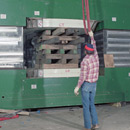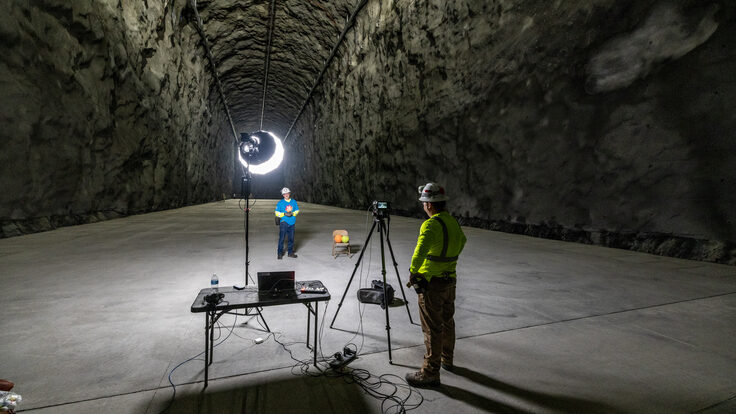|
Old giant hangs on
In biology, there is a loose rule of thumb that says the bigger an organism, the longer its life will be. If Fermilab's "Jolly Green Giant" is any indication, the rule may also apply to equipment in high-energy physics. The Jolly Green Giant (JGG) is a 250-ton magnet, named for its size and bright green color; finally, it might be retiring after a 40-year career of steering particles in high-energy physics experiments. A few weeks ago, two of JGG's four pancake-shaped coils shorted and started leaking water. "The magnet is not dead yet, but badly wounded," says Leon Beverly of Fermilab's Particle Physics Division. In magnet-years, 40 is really old. After performing in four different experiments, and getting a variety of patch jobs and face-lifts, the magnet has outlived the US industrial base that created it.
The JGG magnet was born at Harvard's Cambridge Electron Accelerator. The noted engineer Dave Jacobus designed it in 1964 to guide electrons in the Strauch-Walker experiment, which studied the photo-production of electron pairs involving large momentum transfer. After 20 years at Harvard, the JGG was broken into pieces and transported to Brookhaven National Laboratory (BNL) for the E776 experiment. Ed Hartouni, a University of Massachusetts physicist working at BNL at the time, remembers how the supervising engineer turned the rusty giant into a spectrometer magnet for the experiment. "There were a number of very cool rigging tasks that had to be accomplished. The best was getting the coils onto the steel without damage," Hartouni says. "The magnet was set out on a grassy field, and the place where the lower coils would rest was packed with dry ice, and the coils were set down on it. As the ice evaporated, it settled the coils gently into place."
In 1988, the BNL experiment was transferred to Fermilab's Lab G, and the Jolly Green Giant came with it. Fermilab physicist Dave Christian remembers when the magnet first arrived. "We made the entire floor of thick reinforced concrete, like a very high-quality US interstate highway, so we could put the magnet anywhere in the lab," he says. After helping the E690 experiment study proton-proton diffraction in Lab G, the magnet moved to Fermilab's Main Injector Particle Production (MIPP) experiment in 2002. "Now we use JGG to bend the particles we've produced in collisions so we can track them," says MIPP spokesperson Rajendran Raja. He admits the magnet would be expensive to fix, and possibly impractical, but he isn't quite ready to say goodbye. "We can't quite write JGG off as dead," he says. "We just don't know yet."
Watch a video of the JGG being installed.
Siri Steiner
Click here to download the pdf version of this article.







